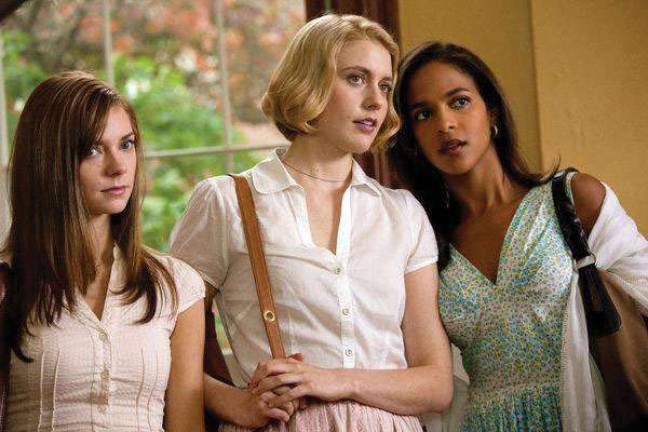Bouquet of Eccentrics

Whit Stillman's 'Damsels' in the clouds "I like my characters to walk in clouds," said the great comedy director Leo McCarey. "I like a little bit of the fairy tale." That confession well describes the McCarey classics that execute a precarious balance between realism and fantasy-The Awful Truth, Make Way for Tomorrow, Love Affair, The Bells of St. Mary's, even his Ruggles of Red Gap (currently in revival at Film Forum)-which took a whimsical approach to the peculiarity of America's historical identity. McCarey's line also describes what distinguishes the films of Whit Stillman, whose new feature, Damsels in Distress, is his first movie in 14 years. The volunteering girls at Seven Oaks College in Damsels in Distress occupy a peculiar world, set apart from working life. They walk in the clouds of the privileged pursuits of youth, enjoying the leisure of education and idealism about politics, romance and religion-in that order of importance, though not obviously so. Violet (Greta Gerwig), a tall, healthy sophomore, is full of private tastes and philosophies-suicide prevention and tap dancing are her causes. She's lucky enough to head her own beautiful-girl clique, a group who support each other and invite newbie Lily (Analeigh Tipton) to join them. They're a bouquet of eccentrics, with names like Rose (Megalyn Echikunwoke) and Heather (Carrie MacLemore) and archly syllabic speech. Yet, like the vulgar beer-and-cocktail boys they are attracted to, each is so pretty and engaging she conveys Stillman's fascination with the same human qualities and conflicts that made McCarey's films so moving. Damsels in Distress is Stillman's youth movie. His previous films, Metropolitan, Barcelona and The Last Days of Disco, surveyed young folk verging on the complications of adulthood, but his long absence has added charitable distance to Stillman's take on maturity. This is, in part, his response to Mumblecore and the opportunity that movement provided for his brand of non-commercial class comedy, but Stillman is too focused and articulate to be mistaken for Mumblecore. His awareness of class has always made him the most idiosyncratic indie. Whereas Mumblecore directors take their social advantages for granted, Stillman makes those advantages crucial to his characters' spiritual struggles. (It's in their romantic gamesmanship and political one-upsmanship, as when Violet jousts with the campus journalist.) Seven Oaks is a Cloud Cuckoo Land version of a WASP enclave, the class and ethnic milieu that is now so foreign to mainstream comedy. Its identifying characteristics disappeared from view with the '60s' social upheaval (a loss addressed by a character in Stillman's Barcelona, who reproves the vulgar ending of The Graduate). This setting allows Stillman to observe and conserve the moral process of people fighting off their anxieties and pursuing contentment, the telling niceties of socializing that once belonged to that forgotten genre, the comedy of manners. By bringing a sense of manners back to the chaos of modern social license, Stillman could inspire Mumblecore to rethink itself in less slovenly terms, as a true aesthetic. (The already iconic Gerwig displays more delicate facets here than her exploitation in Greenberg.) Stillman's eloquent aphorisms and terse epigrams, too funny to repeat here, are spoken in an atmosphere of serenity and halation (photographed by Doug Emmett) that both satirizes and idealizes Ivy League seclusion. It is a world Violet and her gang long to escape by improving, bringing civility and joy in the courtly form of dance. This recalls how The Last Days of Disco, Stillman's richest, deepest film, dared to look back to the waning disco era as a modern pilgrimage. That was Stillman's version of McCarey's whimsical approach to the peculiarity of America's historical identity. His youth movie hopes strongly for our present.